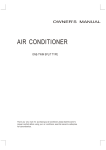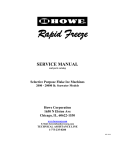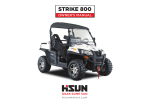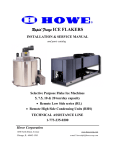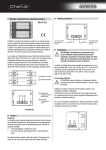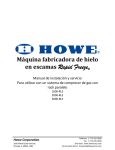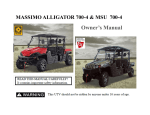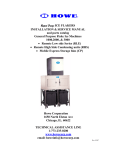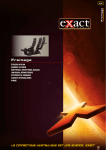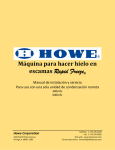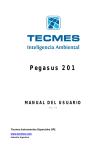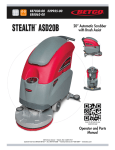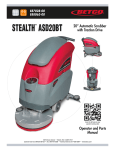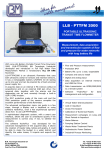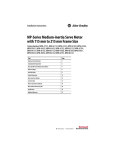Download Rapid Freeze ICE FLAKERS - Catalog
Transcript
Rapid Freeze ICE FLAKERS INSTALLATION & SERVICE MANUAL and parts catalog Selective Purpose Flake Ice Machines 2,000 – 40,000-lb/day capacity • Flooded Ammonia series (RLA) • Recirculated Ammonia series (RLR) TECHNICAL ASSISTANCE LINE 1-773-235-0200 Howe Corporation 1650 North Elston Avenue Chicago, IL 60622 www.howecorp.com e-mail: [email protected] Notice This manual and all information contained herein are provided “as is” and are subject to change without notice. Howe Corporation makes no warranty of any kind with regard to this manual, including, but not limited to, the implied warranties of merchantability and fitness for a particular purpose. Howe Corporation shall not be liable for any errors or for incidental or consequential damages in connection with the furnishing, performance, or use of this manual. The information contained herein is applicable to the specified models current at the time of publication. Some information in this manual will be of use to owners of older model machines. The reader is cautioned that use of this manual with older equipment is at the user’s risk. Howe Corporation makes no warranty or guarantee, explicit or implicit with regard to the use of this manual with equipment models outside the scope of this manual. If in doubt of the scope of this manual, contact Howe Corporation. © Howe Corporation 2005. All rights reserved. Reproduction, adaptation, or translation of this manual is prohibited without prior written permission of Howe Corporation, except as allowed under the copyright laws. Howe Corporation 1650 North Elston Avenue Chicago, IL 60622 Phone: (773) 235-0200 Fax: (773) 235-0269 e-mail: [email protected] web: www.howecorp.com Revision date: October, 2005 - ii - TABLE OF CONTENTS 2. Introduction ................................................................................................................................1 Introduction to the Rapid Freeze® Ice Flaker ................................................................................. 2 Important Safety Information...................................................................................................... 4 Safety Symbols and What They Mean........................................................................................ 4 3. Receiving and Inspection of Equipment...................................................................................5 4. Installation of the Rapid Freeze Flaker....................................................................................7 Installation Conditions ................................................................................................................ 8 Installation without ice bin.......................................................................................................... 8 Installation on Ice Storage Bins .................................................................................................. 9 Recommended Installation Method on Ice Bin........................................................................... 9 Water Supply & Filter Connections.......................................................................................... 10 Wiring & Electrical Connections .............................................................................................. 13 Piping Connections ................................................................................................................... 13 5. Accessories ................................................................................................................................16 Electric Eye Ice Level Control.................................................................................................. 16 Installation Instructions for Photoeye Ice Level Controls......................................................... 16 Ice Bin Thermostats .................................................................................................................. 17 Rib Heating Elements ............................................................................................................... 17 6. Start & Adjust ..........................................................................................................................19 Checklist.................................................................................................................................... 20 7. Electrical Systems.....................................................................................................................23 Control Panel Layout ................................................................................................................ 24 Control Module ......................................................................................................................... 28 8. Maintenance..............................................................................................................................29 Ice Machine Cleaning Instructions............................................................................................ 30 9. Troubleshooting........................................................................................................................35 Operation................................................................................................................................... 36 Freezing and Refrigeration........................................................................................................ 37 Ice Storage and Removal .......................................................................................................... 39 Speed Reducer........................................................................................................................... 40 10. Service & Adjustment ............................................................................................................41 Replacement of Photoeye Ice Level Controls ........................................................................... 43 Replacement and Adjustment of Ice Deflector ......................................................................... 43 Replacement and Adjustment of the Ice Deflector Scraper ...................................................... 44 Replacement and Adjustment Of The Squeegee & Squeegee Wrapper ................................... 44 - iii - Replacement Of Water Pump.................................................................................................... 45 Replacement Of Drive Motor.................................................................................................... 45 Replacement Of Speed Reducer and Flexible Coupling........................................................... 46 Replacement and Adjustment Of Water Float Valve................................................................ 47 Replacement of Solenoid Valve................................................................................................ 48 Replacement and Adjustment of the Hand Expansion Valve (TXV) ....................................... 48 Replacement and Adjustment of Ice Blade ............................................................................... 49 Bearing Replacement ................................................................................................................ 49 11. Appendix A Ice Flaker Drawings..........................................................................................53 12. Appendix B Wiring Diagrams...............................................................................................64 13. Appendix C Parts List............................................................................................................70 - iv - 2.Introduction 2. Introduction -1- 2.Introduction The Rapid Freeze by Howe ice flaker is backed by over 50 years of proven performance and innovation. Long known for durability and reliability, our flake ice equipment is unsurpassed in energy efficiency and low maintenance. Available in a wide variety of sizes and configurations, the rugged Rapid Freeze flaker can be found in diverse applications from supermarkets and food processors to remote fishing villages. Introduction to the Rapid Freeze® Ice Flaker Refer to Figure 1 for a guide to the major components of the Howe ice flaker. Among the key features are: • Evaporator: The heart of the Howe ice flaker is the carbon steel, flooded evaporator. The carbon steel construction provides exceptional heat transfer properties, while the hard chrome lining provides a clean, sanitary, corrosion-resistant freezing surface. • Ice Blade: An investment-cast stainless steel ice blade removes the ice from the freezing surface. The material and method of fabrication mean that the blade will never need resharpening. • Squeegee: Made of USDA-approved material, the squeegee removes excess water from the surface of the ice, guaranteeing that the ice produced by the flaker is dry and subcooled. • Ice Deflector: Mounted underneath the ice blade, the deflector directs the harvested ice toward the center of the drop zone. • Water Distribution Pan: The water distribution pan and tubes provide a continuous flow of water over the evaporator surface. Ice production is rapid and continuous, with no interruption in production. • Water Sump: Collects water that was not frozen on the evaporator, and re-circulates it to the water distribution pan. The incoming water supply is connected here, through a float valve that maintains a constant water level in the sump. • Bearings: Oversized bronze bearings ensure a long service life. • Control Panel: The “brains” of the ice flaker, the control panel governs all of the functions of the ice flaker. Available in a NEMA4 weatherproof enclosure for harsh environments or frequent washdown applications. • Drive Motor: Open, drip-proof drive motor. Totally enclosed, fan-cooled motor available for harsh environments or frequent washdown applications. -2- 2.Introduction Figure 1 Howe Rapid Freeze® Ice Flaker Major Components Drive Motor Speed Reducer Water Distribution Pan Main Shaft Squeegee Ice Blade Evaporator Water Regulating Valve Water Pump Water Return Trough Water Sump Ice Deflector Bearing (Bottom) -3- 2.Introduction Important Safety Information The information found in this manual is intended for use by individuals possessing adequate backgrounds of electrical, refrigeration and mechanical experience. Any attempt to repair or make alterations to this equipment may result in personal injury or property damage. The manufacturer or seller cannot be responsible for the interpretation of this information, nor can it assume any liability in connection with its use. Safety Symbols and What They Mean Please read and understand this manual prior to installing or operating this Rapid Freeze ice flaker. You must be completely familiar with the start-up, operation and service of this flaker before you attempt to start, operate or adjust this piece of equipment. The following safety symbols will alert you to any special precautions throughout this manual: ***DANGER*** BEWARE OF HAZARDS THAT CAN RESULT IN PERSONAL INJURY ***DANGER*** ***WARNING*** “DO IT RIGHT” OR RISK SEVERE PERSONAL INJURY. FOLLOW INSTRUCTIONS CAREFULLY ***WARNING*** ***CAUTION*** RISK OF PERSONAL INJURY OR DAMAGE TO EQUIPMENT FOLLOW INSTRUCTIONS CAREFULLY ***CAUTION*** -4- 3.Receiving and Inspection of Equipment 3. Receiving and Inspection of Equipment -5- 3.Receiving and Inspection of Equipment Upon receipt of your Rapid Freeze ice flaker, you should first inspect the carton very carefully, to determine if any damage might have occurred during shipment. If you suspect any damage has occurred, it should be noted immediately on the freight bill. In addition, a written notice must be sent to the agent representing the freight carrier. The written notice should request an inspection by the agent to verify damage during shipment. If the damage was noticed after un-crating of the carton, it is necessary to keep the original shipping container so that the carrier’s agent can investigate the damage claim thoroughly. If a repair is necessary for the Rapid Freeze machine, you must first obtain written permission from the factory before beginning any repairs. Unauthorized work on your Rapid Freeze ice flaker could result in voiding the machine’s warranty. Immediately upon receipt of equipment, before placement or installation of equipment, verify the electrical, and refrigerant configuration are correct as ordered. If any discrepancies are found, notify Howe Corporation immediately prior to any installation. -6- 4.Accessories 4. Installation of the Rapid Freeze Flaker -7- 4.Accessories Installation Conditions Rapid Freeze Ice Flakers are designed to operate in ambient temperatures warmer than 50°F. Do not install ice flaker(s) in refrigerated cold rooms or in areas where the ambient temperature is lower than 50°F (10°C). If it is unavoidable, ice flakers may be installed in areas down to 45°F (7°C) provided that three (3) electric rib heaters (available from the factory) are installed to heat the bottom casting to prevent ice buildup on the three supporting ribs for the bottom bearing. If installed in cold ambient conditions, it is advisable to supply the ice flaker with warmer water through a water mixing valve, around 60°F (15°C). When a combination of cold water and cold air temperature exists, the mixing valve and rib heaters must be used. Failure to do so will cause the lower water collecting trough and sump to plug up with ice to the extent that the water may overflow into the ice storage bin in addition to blocking the water inlet to the pump. Also, it is advisable to direct air blowers and fans away from the ice flaker, as air velocity over the ice flaker will reduce the effectiveness of the heaters. ***CAUTION*** NEVER INSTALL AN ICE FLAKER IN A COLD ROOM 45°F (7°C) OR LOWER. THE ICE FLAKER WARRANTY IS VOID IF THE ICE FLAKER IS INSTALLED IN A COLD ROOM, OR OUTSIDE WHERE THE AMBIENT TEMPERATURE MAY DROP BELOW FREEZING. ***CAUTION*** Optimum surrounding air temperature range Minimum air temperature (without heater) Minimum air temperature (with heater) Maximum air temperature Optimum water temperature range Minimum water temperature (without water mixing valve) Minimum water temperature (water mixing valve must be used) Maximum water temperature 60°F (15°C) to 95°F (35°C) 50°F (10°C) 45°F (7°C) 100°F (38°C) 60°F (15°C) to 80°F (25°C) 45°F (7°C) 36°F (2°C) 90°F (32°C) Installation without ice bin Rapid Freeze Ice Flakers may be installed under certain conditions without a typical ice bin. When the flaker is installed without a bin, it must have a drainable condensate pan located under the machine. The flaker must also be mounted high enough off the floor so there is no chance that somebody may reach into the evaporator from below either with a pole, or their arm, while the flaker is operating. Refrigerating the ice storage bin is not normally necessary nor is it recommended. However, in those cases where ice is to be discharged into an existing freezer room then, as a minimum, electric heaters should be installed on the bottom casting and the sump regardless of the actual ambient temperature of the air surrounding the ice flaker. Air from the freezer room should be directed away from the ice flaker opening otherwise, the effectiveness of the heaters will be reduced. If the storage area is held at 28°F (-8°C) or colder, it is advisable to install the ice flaker 1 to 2 feet above the freezer and use a duct section to direct the ice into the storage bin. -8- 4.Accessories Installation on Ice Storage Bins Rapid Freeze® Ice Flakers are designed to run smoothly and without vibration. The machines are usually mounted directly on top of an insulated ice storage bin. The storage bin must have an insulated top, with a drip pan that is an integral part of the top designed specifically for the Rapid Freeze Ice Flaker model installed on it. The ice bin should be designed to support the weight of the flaker, and the ice stored inside the bin. Most ice storage bins can handle the weight of a 2000, 3000, 4000 or 6000 pound capacity ice flaker without any additional bracing. It is recommended that the bin manufacturer be consulted before any ice flaker is placed on top of a bin. The weight of each ice flaker machine, along with the diameter of the hole required for ice entry into the bin, is given on the specification sheet for that particular model. Allow for a MINIMUM OF 6" clearance on top of the ice flaker for removal of the speed reducer, and sufficient space around the unit (approximately 3 feet) for inspection and service. Recommended Installation Method on Ice Bin Refer to bin manufacturer’s installation instructions for proper assembly and set up procedures. Locate and set the bin on a solid level footing. Once the bin is set in place and leveled, the Rapid Freeze ice flaker can be placed inside the drip pan. Exhibit 2 illustrates the forklift and block method of placing the ice flaker on the bin. Forklift & Block Method You will need: 9 9 9 9 Forklift truck with adequate load and height capacities (8) 2 X 4 wood blocks approximately 6-8" long (2) 2 X 4 's approximately 36" long Pry Bars Step 1. Position ice flaker on forks. Step 2. Stack two wood blocks in each corner of the drip pan on the ice bin. Step 3. Lift ice flaker over the wood blocks, position ice drop zone over the bin top opening, then set the flaker on the blocks. Step 4. Remove forklift. Step 5. Stack the two 36" long 2 X 4's on the side of the bin beside the drip pan, overlapping the front and back of the bin. Step 6. Using a pry bar as a lever on the 2 X 4's raise the side of the flaker and remove the TOP blocks only. Step 7. Repeat steps 5 & 6 on the other side. Step 8. With the flaker sitting on one (1) block under each corner, repeat steps 5, 6 & 7 removing the remaining blocks. Drip pan flanges MAY bend slightly. Step 9. Straighten the drip pan flanges (if necessary) -9- 4.Accessories Figure 2 Ice Flaker Installation Water Supply & Filter Connections WATER LINE: Connect a 1/2" galvanized or 1/2" ODS COPPER water pipe from the closest convenient water line to within 2 to 4 feet of the ice flaker water sump. Install a water line shutoff valve near the ice flaker. Use copper tubing between water valve & water inlet connection located on water sump. Refer to the engineering sheet for the line size connection from the ice flaker sump to the water supply line. If water supply has silt or sand in it, a coarse water filter is recommended. - 10 - 4.Accessories ***CAUTION*** MINIMUM WATER PRESSURE OF 30 PSIG IS REQUIRED AT THE ICE FLAKER FOAT VALVE TO INSURE ADEQUATE WATER FLOW. MAXIMUM ALLLOWABLE WATER PRESSURE TO THE FLOAT VALVE IS 60 PSIG. ***CAUTION*** Figure 3 Water Supply & Filter Connections ***WARNING*** NEVER OPEN CHARGING VALVE, ALLOWING REFRIGERANT TO VENT DIRECTLY TO THE ATMOSPHERE. REFRIGERANT MUST BE RECLAIMED THROUGH A RECOVERY SYSTEM. ***WARNING*** - 11 - 4.Accessories ***CAUTION*** SERVICE/INSTALLATION PERSONNEL MUST HAVE KNOWLEDGE OF REFRIGERATION SYSTEMS TO PROPERLY CHARGE THIS FLAKER. ***CAUTION*** ***WARNING*** ALL RAPID FREEZE REMOTE MODEL ICE FLAKERS ARE SHIPPED WITH A SMALL HOLDING CHARGE OF DRY NITROGEN. SYSTEM MUST BE EVACUATED PRIOR TO CONNECTING TO THE AMMONIA SYSTEM. ***WARNING*** Follow good accepted practice and procedure to charge refrigerant into the system briefly outlined as follows. 1) Pressurize and test the system checking for leaks. 2) Use a good quality vacuum pump to evacuate the system. Make sure all shut-off valves are OPEN so that the entire system is evacuated. Allow vacuum pump to run for several hours. 3) Break vacuum with refrigerant and evacuate again. 4) Repeat step 3. This is called "triple evacuation". It ensures that all air and moisture has been removed from the system. Failure to do so may result in compressor burnout. - 12 - 4.Accessories Wiring & Electrical Connections ***CAUTION*** ELECTRICAL WIRING SHOULD BE PERFORMED BY QUALIFIED TECHNICIANS FOLLOWING LOCAL ELECTRICAL CODES. ***CAUTION*** The electrical control panel is supplied with remote low side (-RLA or RLR) machines, but is shipped loose to be mounted on the wall (near the bin) for easy access to controls. To install control panel: 1) Install disconnect (not supplied by factory), and connect main power to terminals marked L1 and L2 in the ice flaker control panel. 2) Install optional on-off switch to the two terminals designated "On-Off switch". Remove wire jumper on these terminals if you are installing a remote switch. 3) A jumper is installed between terminal marked “Line A” and terminal marked "Line B". This will enable the liquid line solenoid on the ice flaker to operate properly. 4) Following local applicable electric codes, wire the remote panel to the components (drive motor, water pump, and solenoid valve) on the flaker. The drive motor and water pump should be wired to terminals T1, T2, and T3 respectively, in the control panel. The solenoid valve, and dual pressure regulator are wired to terminals marked, “solenoid valve” in the flaker control panel. 5) If the flaker has factory installed/supplied photo eye ice level controls, connect the long cables from the ice flaker to the relay base (or terminal strip) in the control panel. The wires are color-coded and must be connected to the proper terminals. The BLUE leads from both the emitter and receiver cables connect to terminal # 10 (Blue terminal), the BLACK lead from the receiver only, connects to terminal # 11 (Black Terminal), and the BROWN leads from both the emitter & receiver connect to terminal # 1 (Brown Terminal). Refer to Figure 15 on page 68 for electric eye wiring diagram. ***WARNING*** THE SENSOR LEADS FOR THE ICE LEVEL CONTROLS MUST NOT BE RUN IN THE SAME CONDUIT AS THE MOTOR AND SOLENOID WIRES. SENSOR WIRES MUST BE RUN IN SEPARATE CONDUIT. ***WARNING*** Piping Connections When installing the ice flaker, it is important that the flaker is properly piped as indicated below. When connecting to a AMMONIA refrigeration system, a dual pressure regulator valve must also be provided and installed on the suction line to regulate the evaporator suction temperature to between –5°F and -10°F (-20.4°C to -23.2°C). - 13 - 4.Accessories Table 1 Flooded Ammonia Piping Connection Sizes Approximate Ammonia Charge (lbs.) Liquid Suction 2000-RLA 15 ½” 1” 3000-RLA 18 ½” 1” 4000-RLA 22 ½” 1 ¼" 6000-RLA 35 ½” 1 ¼" 50-RLA 130 ½” 1 ½” 75-RLA 190 ½” 2” 100-RLA 240 ½” 2” MODEL 200-RLA Re-Circulated Ammonia Piping Connection sizes Approximate MODEL Ammonia Liquid Suction Charge (lbs.) 2000-RLR 8 ½” 1” 3000-RLR 12 ½” 1” 4000-RLR 15 ½” 1 ¼" 6000-RLR 22 ¾” 1 ½" 50-RLR 75 ¾” 2” 75-RLR 125 ¾” 2” 100-RLR 150 1” 2 ½” 200-RLR 280 1” 3” The ice flaker as, supplied by Howe Corporation, was thoroughly cleaned and dehydrated at the factory. Foreign matter may enter the system by way of the field piping. Therefore, care must be used during installation of the piping to prevent entrance of foreign matter. Install all refrigeration system components in accordance with applicable local and national codes in conformance with good practice required for the proper operation of the system. The following procedures should be followed: a. Do not leave dehydrated equipment or lines open to atmosphere any longer that is absolutely necessary. b. Suction lines should be sloped ¼” per 10 feet towards the compressor. c. Pipes sized for normal runs (up to 100 FT) d. Avoid excessive number of elbows/bends in all refrigerant lines, especially suction lines. e. Use SCH 80 steel pipe for all ammonia lines except suction lines 1-1/4” and larger may be SCH 40. - 14 - 4.Accessories Figure 4 Refrigerant Piping Support 1. Ensure that refrigerant lines are supported and fastened properly. See Figure 4 for an example. 2. When changing directions in a run of tubing, no corner should be left unsupported. Supports should be placed a maximum of 2 feet in each direction from the corner. 3. Do not use short radius ells. Short radius elbows have points of excessive stress concentration and are subject to breakage at these points. 4. Thoroughly inspect all piping after the equipment is in operation and add supports wherever line vibration is significant. Extra supports are relatively inexpensive as compared to refrigerant loss. Line Insulation After the final leak test, refrigerant lines should be insulated to reduce heat pick-up and prevent the formation of flash gas in the liquid lines. Suction lines should insulated with ¾” wall Armstrong “Armaflex” or equal. Liquid lines should be insulated with ½” wall insulation or better. Insulation located in outdoor environments should be protected from UV exposure to prevent deterioration of the insulation. - 15 - 4.Accessories 4. Accessories Electric Eye Ice Level Control The use of a suitable ice level control to shut off the ice flaker when the storage bin fills is mandatory. Failure to use the proper ice level control will cause the ice to build within the ice flaker evaporator after the bin is full to capacity. Operating the flaker with a full bin will cause the ice deflector to bend or break as it “churns” the ice. In extreme cases it may result in damage to the speed reducer and/or the electric drive motor and flexible coupling. The proper and approved bin level control is the photoelectric eye. When ordered with the machine, the eyes are mounted on brackets that will attach to the bin top or wall. The cables are routed through the bottom casting of the ice flaker. The power module is mounted inside the ice flaker control panel. Figure 5 Electric Eye Ice Level Control Installation Instructions for Photoeye Ice Level Controls 1) Turn off the ice flaker at the control panel and at the main shut-off disconnect. Cover or remove any ice that may be present in the ice storage bin. 2) Open the front cover of the flaker control panel. Locate the 11-pin mounting base for the photoeye control module. If the control module is installed in the base, unplug the control module. 3) Mount the photoeye emitter. If the storage bin top was supplied by Howe, there will be recessed pockets in the bin top for placement of the photoeye elements. If pockets are not present, mount the emitter securely to the top or side wall of the bin, and align the emitter so that it projects its beam directly across the ice drop opening. 4) Locate the photoeye receiver. Again, if the storage bin top was supplied by Howe, there will be recessed pockets in the bin top for placement of the photoeye elements. If pockets are not - 16 - 4.Accessories present, mount the emitter securely to the top or side wall of the bin, and align the receiver so that it is directly across the ice drop opening from the emitter. DO NOT permanently affix the receiver. Leave enough adjustment to ensure proper alignment with the emitter. 5) Run the long cables through one of the knockouts furnished on the side of the control panel. 6) Connect the wires to the control module base as shown in Figure XX. NOTE: If a wire jumper is installed between terminals 5 & 6, it must be removed for the photoeye controls to operate properly. 7) Plug the control module into the base. 8) Check to ensure that the control panel ON/OFF switch is in the Off position. Turn on the main power disconnect. 9) Align the photoeye receiver. This alignment is critical to the proper operation of the level controls. a. Check the LED on the emitter. With the disconnect switch ON, the red LED on the emitter should be glowing. If the light does not come on, check the Molex plug and the connections on the base until the LED lights. b. Move the receiver until the LED on the receiver lights. When proper alignment has been achieved, secure the receiver. c. Check once more that the LEDs on both the emitter and receiver are lit. Realign or tighten loose connections as necessary to keep both LEDs lit. 10) Reroute and fasten cables as necessary. If the photoeye elements are installed in the ice bin (as opposed to in recessed housings in the bin tops), leave enough slack in the cables to provide for “drip loops” in the cables, so that condensation will travel down the cables and drip into the bin, and not onto the emitter or receiver. DO NOT run the photoeye cables close to high-voltage wires. High-voltage wires will interfere with the low voltage control signals, and may cause the ice flaker to shut down. 11) Turn on the control panel ON/OFF switch. The flaker should begin making ice within minutes. Ice Bin Thermostats The use of a bin thermostat is not recommended and is not permitted. The Rapid Freeze ice flaker is designed so that the freezing drum (operating at –5°F) is located directly over the ice drop opening in the bin. This large opening permits cold air to cascade off the evaporator down into the bin. Since the air temperature in the bin is equal to or lower than the ice temperature, the set point of the thermostat cannot be adjusted with sufficient accuracy to distinguish temperature difference upon contact with the ice. Use of a bin thermostat for level control will void the product warranty. Rib Heating Elements Rapid Freeze ice flakers are designed to operate in ambient temperatures between 50°F (10°C) and 100°F (38°C). When operating in ambient temperatures between 50°F (10°C) and 45°F (7°C), rib heaters must be installed on the ice flaker. Under no circumstances is the machine to be allowed to operate in ambient conditions below 45°F (7°C). - 17 - 4.Accessories Factory installed rib heaters are available on all sizes and configurations when ordered with the ice machine. These heaters are installed in the three ribs on the bottom casting, inside the evaporator section of the ice flaker. These heaters warm the ribs and water return trough to prevent the accumulation of ice inside the evaporator. General Purpose ice flakers (1,000 – 6,000-lb/day) cannot be retrofitted with rib heaters if they were not installed at the factory. Carefully consider the installation conditions prior to ordering the ice flaker, to ensure that all necessary equipment is furnished. - 18 - 5. Maintenance 5. Start & Adjust - 19 - 5. Maintenance Once installation has been completed, the ice flaker has been properly evacuated and charged with the Freon identified on the ice flaker label, you may proceed with the check and adjust section. Checklist 1) ______ Before power is turned on, open inlet water valve (field supplied & installed near the back of the ice flaker) and check water level in sump. The water level in the sump is the same as the return trough; it should be about half full (see Figure 6 below). Figure 6 Sump Water Level 2) ______ Make sure the ON/OFF switch is in the OFF position, then turn on the main disconnect. 3) ______ Check voltage between line 1 and line 2, and verify that it is within nameplate ratings. 4) ______ Turn the ON/OFF switch ON. 5) ______ Verify that the solenoid valve has opened (the valve will click loudly). 6) ______ Verify that the drive motor and water pump start. 7) ______ Verify that water is delivered to the distribution pan located inside the evaporator. - 20 - 5. Maintenance 8) ______ Verify that the distribution pan water level is maintained at the half full point. Open or close the water adjustment valve until the water level is maintained at the proper level (see Figure 7 below)(20 ton model ice flakers have a distribution ring). Figure 7 Water Distribution Pan Water Level 9) ______ Allow 10-15 minutes to let the ice flaker come down to temperature and balance out. 10) ______ Verify that ice is being frozen and harvested over the entire surface of the evaporator. If it is, skip to step 14) below. If it is not, continue to the next step. 11) ______ Check the suction pressure at the ice machine Suction temperature must be maintained between -5°F & -20°F (depending on model flaker) at all times. 12) ______ Adjust Dual Pressure Regulator, Low range (operating) to 9-12PSIG (-5 to 10°F), 3-6 PSIG (-20°F for 20 ton) High Range (relief) to 65-75 PSIG. 13) ______ Recirculated ammonia suction temperature is -5°F, Adjust the hand expansion valve(s). Adjust the hand expansion valves to meter the correct amount of Liquid to fill each circuit. Adjust the adjustment stem 1/8 to 1/4 turn at a time (counterclockwise to open the valve if the evaporator was not freezing ice on its entire length). Wait 10-15 minutes between each adjustment to allow the valve and machine balance out. Repeat this step until ice is produced and harvested all the way down to the bottom of the evaporator. 14) ______ When the ice maker is adjusted and operating properly, turn ON/OFF switch OFF, and verify that the solenoid valve closes (the valve will click loudly). 15) ______ Verify that the off-delay is set correctly. After the ice flaker is turned OFF, the drive motor and water pump will continue to operate for a period of time. This should be adjusted to allow the drum to be cleared of residual ice after the solenoid valve is de-energized. This ensures that, when the drive motor and water pump stop, the evaporator will be free of ice. If necessary, adjust the off-delay (see page 28 for location). 16) ______ Turn the ON/OFF switch ON. - 21 - 5. Maintenance 17) ______ Verify operation of the photoeye level controls. Block the path of the infrared beam. After a built-in 15 second delay, the shutdown cycle will begin. If the ice flaker does not begin shutdown, adjust the photoeyes per instructions of page 16. 18) ______ Unblock the photoeye beam, and verify that the ice flaker re-starts immediately. 19) ______ Adjust the electronic overload setting (see page 28 for location). Slowly turn the overload setting counterclockwise, just to the point that the flaker shuts down on overload. Turn the overload adjustment ¼ turn clockwise, reset the overload device, and re-start the flaker. This will insure that the drive motor is adequately protected, but will not cause nuisance shutdowns. 20) ______ Verify that the ice flaker is adjusted and producing dry flake of ice. 21) ______ Verify that water is NOT dripping into the bin. If it is, locate the dripping point and correct it (i.e., distribution pan overflowing, water recovery trough overflowing, or distribution tubes broken or misaligned). - 22 - 5. Maintenance 5. Electrical Systems - 23 - 5. Maintenance Controls for Ammonia Ice Flaker During operation While the ice flaker is in operation, the liquid line solenoid valve will be energized, allowing liquid to enter the surge drum through the ammonia lp float valve. The dual pressure regulator solenoid (mounted on the suction line) will also be energized. When this solenoid valve is energized, the evaporator pressure is regulated @ 12-9 psig, assuming the suction pressure on the system side of the regulator is lower. During shut-down When the ice flaker is shut-down, both the liquid line solenoid, and the dual pressure regulator solenoid are de-energized. The liquid line solenoid positively stops liquid from entering the surge drum and evaporator, while the dual pressure reg. will switch to the higher setting which is 75 psig. Pressure in the surge drum and ice flaker will rise as the ice flaker warms up. When pressure reaches 75 psig, the dual pressure regulator opens, relieving pressure into the suction line. Even in the event of a power failure, the dual pressure regulator will act as an internal relief valve, burping into the main suction line whenever the ice flaker surge drum and evaporator pressure builds to 75 psig. Dual Pressure Regulator for ammonia ice flakers The dual pressure regulator has two settings for pressure regulation. The first setting, is for normal operating conditions, will be set for approximately 12-9 psig allowing the evaporator to operate at -5°F to -10°F(depending on the model of the ice flaker). The evaporator will operate at this temperature when the solenoid valve on the dual pressure regulator is energized. The second setting, (which actually acts as an internal relief valve) is set at 75 psig, which will burp excess pressure in the evaporator and surge drum into the suction line so the internal pressure of the evaporator will never exceed 75 psig. The safety relief valve set @ 150 psig to atmosphere is ultimate safety required by code. - 24 - 5. Maintenance Electric Control Panel Operation (Ammonia) "Start" Sequence When "on-off" selector switch is manually turned the "on" position the following events occur to start the ice flaker system (provided the "optional" photo electric eye is calling for ice). 1) Relay #1 is energized causing contacts 8 & 6 (R1) to close, and contacts 3 & 1 (R1) to close. 2) Closing of contacts 21 & 24 (R1) causes off-delay timer to reset and will close contacts TR1 (N.O.T.O.) 3) Ice flaker contactor is energized and drive motor and water pump start (provided overload holding contacts (M1-MP, M2-MP) are closed indicating overload condition does not exist) and ice flaker "run" light (green) will light. 4) When ice flaker contactors are energized auxillary contacts (M1, M2, R1) close, thereby energizing liquid line solenoid valves. (Liquid line & Dual Pressure regulator) "Stop" Sequence When selector switch is manually turned to "off" position (or if the ice level control is satisfied) the following events occur to stop the system. 1) Relay #R1 is de-energized causing contacts 21 & 24 (R1). To open which initiates the off delay time period. 2) Opening of contacts (R1) causes liquid line solenoid valve to de-energize and close. 56) After set time, (20 minutes) contacts TR1 open, de-energizing ice flaker contactor. Ice flaker is off and flaker "run" light (green) is off. - 25 - 5. Maintenance Control Panel Layout Figure 8 E20T40-RL Exterior Panel Layout Remote Low Side Ice Flakers 4 2 3 1 1) On/Off Switch: Main On/Off switch for the control circuit. This switch is wired in series with the (optional) field-installed switch and the photoeye ice level control. 2) Ice Flaker Run Light: Green light is on whenever the contactor and drive motor are energized. 3) Motor Overload Light: Amber light is on whenever the electronic overload opens, stopping the drive motor and water pump. 4) Overload Reset Button: Normally-open reset button, resets overload circuit following overload condition. - 26 - 5. Maintenance Figure 9 Ice flaker Control Panel Interior Layout 1 3 2 4 5 6 7 8 9 10 11 12 1) Motor Contactor: Provides power to the drive motor and water pump. Energized during freezing and pump down cycle, then timed off for shut down. Auxiliary contact provides power to the liquid solenoid valve when the contactor is energized. 2) Control Transformer: Provides 24V control power to the control panel components, control module, motor contactor, and indicating lights. 3) Control Module: Main control processor. Incorporates motor overload, operating circuit, and off-delay circuit. Controls motor contactor and solenoid valve power. 4) Photoeye Power Module: Processes signals from electronic eye level control, with built in time delay. Shuts machine off when ice bin is full, to prevent damage to the flaker due to ice backing up into the evaporator. 5) L1, L2, L3 Terminals: Main power terminals for field-wiring electric power to control panel. Single-phase (standard) power is wired to L1 and L2. Three-phase power is wired to L1, L2, and L3. 6) T1, T2, Motor/Pump Terminals: Terminals for wiring drive motor and water pump. May be factory- or field-wired. 7) Solenoid A1, A2 Terminals: Terminals for field-wiring liquid solenoid valve wires. 8) Heater A1, A2 Terminals: terminals for field-wiring electric rib heater wires. - 27 - 5. Maintenance 9) A, B Terminals: Terminals for providing Line 2 power to solenoid valve. On models with condensing units, wired through compressor safety switches (high discharge pressure and high oil pressure) to assure liquid solenoid valve will de-energize if the compressor shuts down on a safety failure. When connected to a refrigeration rack, or ammonia system, a wire jumper is placed between line “A” and line “B” in the flaker control panel. 10) Terminals 1-8: Terminals for field-wiring condensing unit indicator lights. (not applicalble for ammonia ice flakers 11) On/Off Switch Terminals: Terminals for installing a remote On/Off switch or auxiliary control such as a 7-day clock timer, or remote modem. These auxiliary controls must be wired in series with the panel-mounted On/Off switch, and factory-wired photoeye ice level control, so that all three switches must be closed to start the machine, but opening any switch will shut the machine off. 12) Photoeye Terminals: Terminals for installing photoeye level control emitter and receiver. Control Module The E20T48 control module is the main processor for the ice flaker control panel. It incorporates the timer functions, control relay functions, and overload relay functions: Motor Overload Adjustment: Adjusts the sensitivity of the motor overload protection device. Set at factory. Adjust only if the motor shuts off on overload and there is nothing preventing the motor from turning (i.e., ice collecting in the evaporator, very soft ice, seized bearings, etc.). Off-delay Timer Adjustment: Sets the delay between turning the flaker off (closing the solenoid valve) and shutoff of the motor and water pump. Factory set. Adjust only if ice is still present in the evaporator when the motor and water pump shut off, or if the motor and water pump operate for an excessive period of time after the evaporator stops freezing the feed water. Terminal Number 1,2 Description 24 VAC input power. 3 Ice Flaker run input signal (all ON/OFF switches, ice level controls, and any special controls must be in this circuit). 4 Overload reset input (normally open, momentary contact). 5 Motor overload output (for overload indicating light). Energized upon overload condition, stays on until overload is manually reset. Red LED on control module indicates overload condition. This LED will glow prior to actual shutdown of drive contactor. 6 Ice flaker contactor output (output is energized when input signal is present and control is not in overload condition). When input signal is removed (switch or ice level control open) timer circuit is started. Output will stay energized until timing circuit releases output. Output is de-energized immediately upon overload condition. 7,8 Isolated output contacts for liquid solenoid valve (normally open). Contacts close immediately upon input signal (#3), stay closed until input signal is removed. Contacts open when input signal is removed, or when overload condition exists. - 28 - 5. Maintenance 5. Maintenance - 29 - 5. Maintenance Evaporator To keep the evaporator in peak performance, the ice flaker should be cleaned with an approved ice machine cleaner at least twice a year (more often if water conditions cause mineral build up) using an approved food grade ice machine cleaner. The water pump is used to circulate ice machine cleaner through the system. Refer to cleaning instructions below for complete cleaning instructions. Ice Machine Cleaning Instructions An important part of ice flaker maintenance is to clean it frequently so that the water passages are not clogged and the freezing surface is clear and free of scale caused by calcium and iron deposits. Frequency of cleaning depends upon the quality of water. In extreme hard water areas, it may be necessary to clean the flaker as often as every 2 months, whereas in normal or "soft" water areas twice a year may be sufficient. When cleaning is necessary, proceed as follows: 1. Turn off refrigeration compressor. If flaker is connected to a compressor rack, close the liquid line shut off valve. 2. Turn off the ice flaker switch, and adjust the off delay time adjustment fully clockwise. 3. Remove all ice in storage bin. 4. Close water supply shut off valve. 5. Drain water from the drain connection in water sump. Some models are equipped with a drain valve, others have a drain plug, located below the water float valve connection. 6. Prepare the cleaning solution, following the instructions on the bottle. ***CAUTION*** USE APPROVED ICE MACHINE CLEANERS ONLY. MIX SOLUTIONS IN ACCORDANCE WITH THE MANUFACTURER’S INSTRUCTIONS. ICE MACHINES CLEANERS CONTAIN ACIDS, WHICH MAY CAUSE BURNS. HANDLE WITH CARE. IN CASE OF EXTERNAL CONTACT, FOLLOW FIRST AID INSTRUCTIONS ON THE BOTTLE. IF SWALLOWED, SEEK IMMEDIATE MEDICAL ATTENTION ***CAUTION*** 7. Pour solution of ice machine cleaner into sump, to normal operating level. Do not overfill, as the water may overflow into the ice storage bin. 8. Start the ice flaker drive motor and water pump by turning the switch on, then immediately off. This will allow the gear motor & water pump to run for approximately 30 minutes with out refrigeration, to circulate cleaning solution over the freezing surface and all water passages. Operate until all scale is removed. This may require from half hour up to 2 hours if scale build up is heavy. 9. When system is clean, drain cleaning solution and rinse with 2 or more complete rinses to insure that cleaning solution is flushed away thoroughly. At each rinse, fill sump with fresh water and run drive motor and water pump for 10 minutes, then drain. - 30 - 5. Maintenance TO SANITIZE: 10. Mix a solution of approved sanitizer, or mix 16 oz. of household bleach with 2 gallons of warm water, 90-115°F. 11. Pour solution into sump, to normal operating level (as in #7 above), then re-circulate sanitizing solution for approximately 20 minutes, by turning on drive motor & water pump. 12. Drain solution and rinse thoroughly with fresh water at least twice, following procedure described in #9 above. 13. After ice flaker is thoroughly rinsed, return machine to normal operation by opening water supply valve, readjusting off delay timer setting to previous set point, restoring refrigeration, and turning the machine back to ON. Water Distribution Tubes Water distribution tubes should be kept clean and free of any mineral buildup. When they do accumulate mineral deposits, the flaker must be thoroughly cleaned. Remove each tube and clean with cleaning solution and small tubing brush. Carefully inspect each distribution tube and fitting for leaks or cracks. Replace defective tubes when necessary. Water Sump Water sump and pump should be kept clean and free of any mineral buildup. When mineral deposits accumulate the machine must be thoroughly cleaned. The water sump will be cleaned when you normally clean the equipment by circulating the ice machine cleaner through the water system. In extreme cases of mineral or slime buildup, shut off the main power and remove the top covers from the sump, and using the ice machine cleaner and a scrub brush clean the aluminum sump body until the deposits are removed. Water Filter Back Flushing A unique feature of the Howe water filter system is the cartridge back flush capability. The unique omni-directional cartridge design permits back flushing of the cartridge in the event of a premature plugging before the 6-month life has occurred. In most cases, this will not be necessary, however when there are large accumulations of sediment and dirt caused by line interruptions (construction and heavy rain conditions), back flushing will permit the cartridges to be used for their rated life. To back flush the cartridges, perform the following functions: 1. Close shut-off valve on outlet of manifold. 2. Close shut-off valve on inlet of manifold. 3. Release bottom manifold from quick disconnect fittings on filters. 4. Reverse direction of filters on manifold system. 5. Re-attach bottom manifold to filters. 6. Open flush valve on bottom manifold and put flush hose into bucket or drain. 7. Open shut-off valve on inlet of manifold and accumulated dirt will be flushed out of filter. - 31 - 5. Maintenance 8. Close shut-off valve on flush hose and open outlet valve on manifold. The pressure in the system should now be operational for use. Note: If pressure does not return to normal zone on gauges, reverse the filters and reperform functions 5 through 8. When the pre filter element in the clear pre filter housing becomes discolored, this is the indication that it needs to be replaced. Lubrication Bearings & Seals Main bearings on the ice flaker should be greased every three months using FDA-approved food grade edible grease. The grease fittings are easily accessible from the front of the flaker; the top bearing is lubricated through a grease fitting accessible through the inspection (service) opening, the bottom bearing is lubricated through a grease fitting on the outer edge of the bottom casting. NOTE: One pump of a grease gun is normally adequate to grease the bearings. Do not overgrease, as this may damage the grease seals at the bearings. Speed reducer Some speed reducers are equipped with a grease fitting to lubricate the bearing on the top slowspeed gear. This bearing must be lubricated (greased) every six months with standard bearing grease (not food grade). The oil in a new speed reducer should be changed at the end of 250 hours of operation. Under normal conditions, after the initial oil change the oil should be changed after every 2,500 hours, or every six months, whichever occurs first. Periodic examination of oil samples taken from the unit will help establish the appropriate interval. When operating the ice flaker in low ambient temperatures (colder than 50°F), synthetic oil should be used in the speed reducer. Rotary Ice Harvesting Blade (20 ton models) The rotary ice blades must be greased every 3 months, The grease fitting is located on the bottom of each blade assembly. Use food grade grease, add grease until it starts to come out of the vent on the blade near the top. Preventative Maintenance The ice flaker should be visually checked daily by a designated employee. This inspection should ensure that: • Photo eyes and brackets are in proper alignment, • Ice quality (size of ice flakes) appears normal, • Ice quantity appears normal, • No bubbles are visible in the sight glass, • The flaker is clean, • No unusual noises are present. When these items are checked on a daily basis, any change will be easily detected prior to any service call for a malfunction of the machine. - 32 - 5. Maintenance Preventative Maintenance Schedule 3 months 6 months 9 months 12 months Clean ice machine * X Check ice harvesting X X X X Clean electric eyes & check alignment X X X X Inspect flaker for damaged parts ** X X X X Inspect squeegee X X X X Inspect water float valve X X X X Inspect deflector scraper X X X X Grease top & bottom bearings X X X X Grease bearings on rotary Harvest blade (20 ton models) X X X X Check and replace speed reducer oil (standard oil) *** X X X X Check and replace speed reducer oil (synthetic oil) *** X X Grease speed reducer bearings † X X Sanitize ice machine * X Check bearing wear †† X Check cutting blade clearance ‡ X Check oil level in oil pot and drain ‡‡ Check rib heaters for proper operation (if furnished) X Replace squeegee As necessary Replace deflector scraper As necessary Replace water float valve As necessary * Clean and sanitize at least annually, more frequently if necessary. ** Inspection should include, at a minimum, the following parts: ice deflector, deflector scraper, squeegee, squeegee wrapper, water distribution tubes, and float valve. *** Speed reducer oil should be changed every 2,500 hours of operation (5,000 hours with synthetic oil), or every six months, whichever occurs first. The above chart assumes continuous operation of the ice flaker. † Only required on speed reducers equipped with grease fittings at the bearings. Use food-grade grease such as Chevron FM or equal. †† Use an industrial feeler gauge. If wear is greater than 0.007", bearings may be wearing excessively. Contact factory for guidance. ‡ Use an industrial feeler gauge. Check blade at top and bottom, in at least four locations around the evaporator (quarter points). Clearance should be 0.004" - 0.006" in all locations. If clearance is not within these parameters, contact factory for guidance. ‡‡ Oil pot should not be insulated. Frost line on oil pot will indicate oil level. When pot is nearly full, drain oil. - 33 - 5. Maintenance - 34 - 6. Troubleshooting 6. Troubleshooting - 35 - 6. Troubleshooting Problem Possible Cause Remedy Operation 1. Ice flaker will not start. 2. Solenoid valve energizes, drive motor contactor does not energize. 3. Solenoid valve does not energize, drive motor contactor energizes. a. ON/OF switch is open. Turn all power switches “ON”. b. Control transformer is defective. Check voltage between terminals 1 and 2 on the flaker control module (part E20T48). Normal reading is 24 VAC. If 24VAC is not present, replace the transformer. c. Control switches are open. Check voltage between terminals 1 and 3 on the flaker control module. With all control switches open, normal reading is 0 VAC. With all control switches closed, normal reading is 24 VAC. d. Photoeye emitter is defective. Check LED on emitter. If LED is lit, emitter is functioning properly. If LED is not lit, check to see that power is turned on, and that all connections between the emitter and control panel are secure. If LED still is not lit, replace emitter. e. Photoeye receiver is defective. Check LED on receiver. If LED is lit, receiver is functioning properly. If LED is not lit, check to see that power is turned on, and that all connections between the emitter and control panel are secure. Check alignment of sensors. If possible, remove sensors form their housings, and hold them a few inches apart. If LED still is not lit, replace receiver. f. Photoeye control module is defective. If both sensors are operating properly (see d. and e. above), replace control module. a. Control module is defective Check voltage between terminals 2 and 6 on control module. If voltage reads 24VAC, replace the control module. b. Contactor coil is defective. Check voltage between terminals 2 and 6 on control module. If voltage reads 0VAC, check wiring and contactor coil for defects. a. Control module is defective. Close all switches; remove wires from terminals 7 and 8 on the control module. With voltmeter set to “ohms,” check for continuity between terminals 7 and 8. If contacts are open, replace the control module. - 36 - 6. Troubleshooting Problem Possible Cause Remedy b. There is a wiring defect. Close all switches; remove wires from terminals 7 and 8 on the control module. With voltmeter set to “ohms,” check for continuity between terminals 7 and 8. If contacts are closed, check the line “A” jumper, CR3contacts, wiring, and solenoid coil. a. ON/OFF switch is defective. Replace ON/OFF switch. b. Photoeye controls are defective. Check per 1.d-1.f above. 5. Solenoid valve is always energized. a. Control module is defective. Replace control module. 6. Ice maker does not shut off when bin is full. a. Photoeyes are not installed. Install photoeyes per instructions on page 16. b. Photoeyes are defective. Check per 1.d-1.f above. a. A speed reducer gear is worn or broken. Repair or replace the speed reducer. b. Electronic overload is set too low. Check amp draw on drive motor. If amps do not exceed the nameplate rating, adjust the potentiometer on the control module clockwise until flaker operates properly. Turn potentiometer counter-clockwise just to the point that the overload trips then turn potentiometer clockwise 1/8 turn. c. Thermal overloads may be improperly sized. Check ratings and install properly sized overloads if necessary. d. Ice blade is “dragging” on the drum. Readjust the clearance on the ice blade as specified on page 49. a. The woodruff key on the slow speed output shaft of the speed reducer has sheared. Repair or replace the speed reducer. 4. Drive motor is always on. 7. Drive motor cuts out on overload. 8. Drive motor runs, but main shaft only turns when there is no ice on the drum. Freezing and Refrigeration 1. Ice freezes along entire length of drum, but harvests only on the upper half. a. System is short of refrigerant. Charge system until there are no bubbles in the sight glass. b. Superheat setting is too high. Open the hand expansion valve 1/4 turn at a time until ice is harvested over entire evaporator. Wait 10-15 minutes between adjustments to allow the system to balance. - 37 - 6. Troubleshooting Problem Possible Cause Remedy d. Head pressure is too low. Adjust or replace head pressure controls as necessary. e. The liquid line filter/drier is dirty. Replace the filter/drier. a. Main bearings are worn. Replace worn bearings. Repair or replace main shaft is excessive wear is detected. b. Ice blade clearance is too high. Check and adjust blade clearance as necessary c. Top casting was misassembled after bearing replacement. Re-align and reassemble the top casting. Contact factory for assistance. 3. Ice freezes and harvests entire height of evaporator, but harvests poorly or at random. a. Feed water is too hard Install a water softening system. b. Freezing surface is coated with hard water deposits. Clean the evaporator surface with ice machine cleaner. 5. No ice freezes on the evaporator, and compressor short cycles. a. Loss of refrigerant charge. Inspect refrigeration system for leaks. Repair as necessary, and recharge system. 6. Flaker makes ice intermittently, and compressor short cycles. a. Undersized water line. Install properly sized water line. b. Low water pressure (under 20 psi). Contact factory for guidance. c. Water filters are clogged. Replace water filters. a. Evaporator temperature is too high. • Check and adjust Dual Pressure regulator (if equipped). regulator should be set between –5°F and –10°F (-20 for 20 ton) during operating cycle. 2. Ice freezes and harvests entire height of evaporator, but harvests on only one side of the drum. 7. Ice flakes are too thin. • Close the hand expansion valve ¼ - ½ turn at a time until ice quality is acceptable. Wait 10-15 minutes between adjustments to allow the system to balance. 8. Ice flakes are too small, with an excessive amount of “snow”. a. Evaporator temperature is too low. - 38 - • Check and adjust hand expansion valve (if equipped). valve should be set between – 5°F and –10°F (-20 for 20 ton). 6. Troubleshooting Problem Possible Cause Remedy 9. Ice flaker “chatters” and does not run smoothly. a. Ice blade clearance is too high. Check clearance and adjust as necessary. b. Main bearings are worn. Replace worn bearings. Repair or replace main shaft is excessive wear is detected. 10. Ice accumulates in the water return trough. a. Ice deflector is not positioned properly. Adjust ice deflector position as specified on page 43. 11. Ice accumulates in the water return trough, sump, and on the “ribs” in the bottom casting. a. Ambient temperature is too low. • If ambient temperature is between 45°F and 50°F, install rib heaters. • If ambient temperature is below 45°F relocate the flaker to a warmer area. See Installation conditions on page 8. Ice Storage and Removal 1. Ice flakes are frozen together in a hard block. a. Ice has been left in the storage bin too long. • Remove ice from the storage bin daily. b. Water level in the sump is too high, causing water to overflow the return trough. Adjust the water float valve to maintain water level approximately ¼” below the return trough. c. Water is overflowing the distribution pan. • Distribution tubes may be plugged. Clean or replace tubes as necessary. • Install a clock timer to limit the ice flaker production. • Level in distribution pan may be too high. Adjust the water-regulating valve to set level in the distribution pan to half-full. d. One or more water distribution tubes is missing or broken. Replace as necessary. e. The lead water tube may be splashing water into the bin. Adjust lead water tube as necessary. f. Condensate drip pan is leaking into the storage bin. Repair or replace drip pan. g. Humidity level in storage bin is too high. • Check and repair bin insulation as necessary. • Check and repair seals on the bin. • Bin door has been left open too long. Close door when not removing ice. - 39 - 6. Troubleshooting Problem 2. Ice in storage bin is too wet. Possible Cause Remedy a. Water level in the sump is too high, causing water to overflow the return trough. Adjust the water float valve to maintain water level approximately ¼” below the return trough. b. Water is overflowing the distribution pan. • Distribution tubes may be plugged. Clean or replace tubes as necessary. • Level in distribution pan may be too high. Adjust the water-regulating valve to set level in the distribution pan to half-full. c. One or more water distribution tubes is missing or broken. Replace as necessary. 1. Oil is leaking between the front of the motor and the motor mounting flange. a. High-speed oil seal in the speed reducer is worn. Replace seal. 2. Oil leaking is evident on the top of the flexible coupling. a. Slow-speed oil seal in the speed reducer is worn. Replace seal. Speed Reducer - 40 - 7. Service & Adjustment 7. Service & Adjustment - 41 - 7. Service & Adjustment ***CAUTION*** THIS INFORMATION IS INTENDED FOR USE BY INDIVIDUALS POSSESSING ADEQUATE BACKGROUND IN ELECTRICAL, REFRIGERATION, AND MECHANICAL SERVICE. ANY ATTEMPT TO REPAIR MAJOR EQUIPMENT MAY RESULT IN PERSONAL INJURY AND/OR PROPERTY DAMAGE. THE MANUFACTURER OR SELLER IS NOT RESPONSIBLE FOR THE INTERPRETATION OF THIS INFORMATION, NOR WILL THEY ASSUME ANY LIABLITY IN CONNECTION WITH ITS USE, ***CAUTION*** ***DANGER*** THE CONTROL PANEL ON THIS ICE FLAKER MAY BE POWERED BY TWO SEPARATE POWER SOURCES. DISCONNECT BOTH SOURCES PRIOR TO SERVICING THIS PIECE OF EQUIPMENT. FAILURE TO DO SO MAY RESULT IN AN ELECTROCULTION HAZARD. ***DANGER*** ***WARNING*** ONLY TECHNICALLY QUALIFIED PERSONS, EXPERIENCED IN THE HANDLING OF REFRIGERANTS AND THE OPERATION OF REFRIGERATION SYSTEMS, SHOULD PERFORM THE OPERATIONS DESCRIBED IN THIS MANUAL. ***WARNING*** - 42 - 7. Service & Adjustment Replacement of Photoeye Ice Level Controls 1. Turn off the main power and remove the 11-pin power module. 2. Locate the sensor to be replaced, and remove the sensor housing cover (if present). 3. Using two open-ended wrenches, placing one on the back nut and one on the forward nut, remove the sensor. 4. Disconnect the old sensor wires from the terminal strip. 5. Connect the new sensors wires to the terminal strip. 6. Install the sensor in the mounting bracket, and tighten the locknuts, taking care not to overtighten as this could damage the sensor, use a maximum torque of 13 lbs-in. 7. Re-install the power module into the base. 8. Turn on main power. 9. Check alignment of the sensors. When proper alignment is achieved, the LED on the receiver will light. Adjust the mounting brackets as necessary to ensure that the sensors are properly aligned. 10. Reinstall the sensor housing covers. Replacement and Adjustment of Ice Deflector To properly install, the upper edge of the deflector should be positioned approximately 1/8" BELOW the aluminum lip under the evaporator. The ice deflector should be centered beneath the ice cutter blade so that as the ice is removed from the evaporator, it will be deflected into the ice bin opening, away from the water-collecting trough. The ice deflector prevents ice from dropping into the water-collecting trough. TO REPLACE ICE DEFLECTOR PROCEED AS FOLLOWS: 1. Shut off ice flaker and allow machine to "pump down" (de-ice). Once the machine is clear of ice, disconnect the main power to the ice flaker and LOCK THE DISCONNECT SWITCH IN THE OFF POSITION (to prevent accidental start up). 2. (larger capacity models may be better serviced form below.) 3. Remove the service access cover on the top casting. 4. Remove 2 or 3 water distribution tubes (if necessary). 5. Reaching up from the bin into the freezing chamber (or down from the top), loosen and remove the two bolts holding the existing ice deflector in place. 6. Remove the damaged ice deflector through the bottom opening. 7. Position and bolt the new ice deflector to the shaft. Tighten the bolts with the deflector adjusted to within 1/8” but NOT touching the evaporator surface or aluminum casting (see Figure 10 below). 8. Re-install the water distribution tubes (if necessary). 9. Remove all tools from inside the machine and re-attach the service access cover. - 43 - 7. Service & Adjustment 10. Remove lockout device from the main power disconnect and turn on the main power. 11. Turn on the ice flaker switch (you may need to press the overload reset button), and check the deflector to insure that it does not touch the evaporator or aluminum casting. 12. If the deflector makes contact with the evaporator surface or aluminum casting at any point, then shut down the machine and repeat the above steps to readjust the deflector. Figure 10 Ice Deflector and Scraper Adjustment Replacement and Adjustment of the Ice Deflector Scraper The ice deflector scraper is mounted on one of the three bottom ribs using two stainless steel bolts and nuts. The scraper’s purpose is to clear any buildup of ice from the ice deflector, as the deflector passes the scraper. When properly positioned, the scraper will be approximately 1/8” above the deflector blade (see Figure 10 above). When replacing the scraper, it may be necessary to cut the angled edge to the proper size and angle. This may be accomplished with either aviation snips or a razor knife. Replacement and Adjustment Of The Squeegee & Squeegee Wrapper (20 ton model does NOT have squeegee installed) Shut off ice flaker and allow machine to "pump down" (de-ice). Once the machine is clear of ice, disconnect the main power to the ice flaker and LOCK THE DISCONNECT SWITCH IN THE OFF POSITION (to prevent accidental start up). 1. Remove the service access cover on the top casting. 2. Remove 2 or 3 water distribution tubes for easier access. 3. Reaching into the freezing chamber, loosen and remove the two bolts holding the existing squeegee and squeegee wrapper in place. 4. Remove the squeegee and wrapper assembly through the service opening. If the squeegee wrapper is not bent out of shape or pitted with rust, then you can remove the rubber squeegee from the wrapper and install a new squeegee in the existing wrapper. 5. Reinstall the squeegee and wrapper assembly onto the mounting bracket in the freezing chamber, hand tighten the nuts with the squeegee touching the evaporator surface, then - 44 - 7. Service & Adjustment move the squeegee assembly approximately 1/16" to 1/8" closer to put pressure on the squeegee causing it to bend slightly so that it will drag on the evaporator surface. 6. Do not install the squeegee assembly so close to the evaporator that the squeegee bends excessively. This may cause premature squeegee wear and increase load on the gearbox and drive motor. 7. Tighten the nuts and bolts only till the lock washers lock. Do not over tighten bolts, as this may cause distortion of the squeegee wrapper and possibly cause premature squeegee wear. 8. Re-install the water distribution tubes. 9. Remove all tools from inside the machine and re-attach the service access cover. 10. Remove lockout device from the main power disconnect and turn on the main power. 11. Turn on the ice flaker switch (you may need to press the overload reset button) and check the squeegee to insure that it touches the evaporator on the entire circumference of the freezing chamber. 12. If the squeegee looses contact with the evaporator surface at any point, then shut down the machine repeating the above steps to readjust the squeegee a little closer. Replacement Of Water Pump 1. Turn off the main power to the flaker. 2. Remove the screws securing the stationary sump cover. 3. Loosen and remove water tube fitting (Nylon compression fitting). 4. Remove the cover from the electrical junction box, ad disconnect the water pump wires from the terminal strip. 5. Lift the water pump (with cover attached) off the sump. 6. Remove the water tube hose and clamp. 7. Loosen and remove the four nuts holding the water pump onto the sump cover. Remove the pump from the cover. 8. To install the new pump, simply reverse the above procedure. Use caution when routing the new cables to insure they are secured to avoid accidental damage. Replacement Of Drive Motor 1. Disconnect main power to the ice flaker. Remove electric wiring cover on the drive motor. Remove the power leads attached to terminals marked L1 and L2. 2. Refer to Figure 11. The drive motor is attached to the gearbox with (4) bolts, through the motor mounting plate. Remove the (4) bolts. The motor may be removed by pulling it away from the gearbox. There are no setscrews or couplings; the motor shaft fits directly into the hollow high-speed input shaft on the speed reducer with a ¼” key. If the old motor cannot be removed easily, then locate two threaded holes on the motor mounting plate. They will be on the horizontal centerline, one on each side of the input shaft. Insert one of the mounting bolts into each threaded hole so they push against the drive motor (you may have to rotate the motor housing so the bolts can press against the mounting lugs on the - 45 - 7. Service & Adjustment motor, making sure the bolts do not thread into the mounting lugs). Turn both bolts until they are hand tight, and then turn each bolt alternately 1/2 turn at a time, until the motor is free enough to remove by hand. 3. When installing the new motor, place the ¼” key on the shaft, lightly grease the surface of the motor shaft, and insert in the hole on the high-speed input shaft, keeping the keyway aligned with the key. When the motor is in place, rotate it until the mounting lugs are aligned with the (4) mounting holes on the motor mounting plate on the speed reducer. Insert a bolt in each hole and tighten. 4. Re attach the flexible power cable to the motor, connect the power leads to terminals marked L1 and L2, check to insure the motor is wired for the correct power (115V or 230V) and for the correct rotation (CCW). Refer to wiring connections on the motor nameplate for the correct connections. 5. When the motor is reattached and connected, turn on power and check operation. Place an ammeter on the power line and check to insure the motor is drawing within the nameplate FLA. Replacement Of Speed Reducer and Flexible Coupling 1. Disconnect main power to the ice flaker. 2. Remove the drive motor as described above. 3. Remove the (4) mounting bolts attaching the gearbox to the top aluminum casting. The gearbox can then be lifted straight up. The top part of the flexible coupling will lift off with the gearbox; the bronze star and bottom part of the coupling will stay attached to the main shaft. 4. Loosen the setscrew on the top part of the coupling to remove it from the gearbox. Care should be taken to avoid oil from seeping out of the relief vent (located on the top of the gearbox in a set screw) if the gearbox is turned on its side or up side down. 5. The bottom part of the flexible coupling is attached to the shaft with a setscrew. Loosen the setscrew, and then lift the coupling off the shaft. The use of a gear puller may be required to assist in removing either part of the coupling. 6. Install the new (or existing if it is not damaged) flexible coupling to the shaft and speed reducer, lining up the keyways with the key. Re-tighten the setscrews in both parts. 7. Place the bronze star on the bottom part of the coupling. 8. Install the gearbox (with top coupling attached) onto the top casting, over the bottom part of the flexible coupling. If the gearbox does not sit on the top casting properly, you may need to loosen one or both of the setscrews on the flexible coupling to allow the gearbox to seat on the machined surface of the casting. There should be a 1/16" gap between the top coupling half and the bronze star. 9. Rotate the gearbox COUNTERCLOCKWISE ONLY until the mounting holes line up. Once aligned re-install the mounting bolts. Re-position the coupling halves with required clearance and re-tighten. - 46 - 7. Service & Adjustment Figure 11 Drive Motor and Speed Reducer Disassembly Replacement and Adjustment Of Water Float Valve 1. Shut off the water supply to the ice flaker and drain the supply line. 2. Loosen and remove the compression fitting at the float valve. 3. While holding the float valve body with pliers or a crescent wrench, remove the water float valve fitting from the valve body. 4. Using a 13/16" socket (a spark plug wrench works well), remove the locking nut from the valve body (you may need to hold the valve body to keep it from turning). 5. Remove the old valve and fiber washer. Install new valve (with fiber washer on the inside of the water sump) and tighten the locking nut with the socket. The valve body should be held in place with the discharge port facing straight down. 6. Re-install the float valve fitting and reattach the water supply line. 7. Turn on water shut off valve and check for leaks at the compression fitting and at the float valve fitting. The water level should be maintained to the point just below the lower edge of the water return trough while the flaker is operating. To adjust the operating level, hold the float in one hand, and push or pull on the brass shaft (depending on whether the water - 47 - 7. Service & Adjustment level is too high or too low.) Watch the operation for a while to verify the water level. If the water level is still not where it should be, re-adjust the float. Replacement of Solenoid Valve ***CAUTION*** ON ICE FLAKERS THAT ARE CONNECTED TO A CENTRAL REFRIGERATION RACK, A JUMPER WIRE MUST BE PLACED BETWEEN TERMINAL “A” AND TERMINAL “B” ON THE TERMINAL STRIP AT THE BOTTOM OF THE CONTROL PANEL. THIS JUMPER WILL ALLOW THE SOLENOID VALVE TO ENERGIZE WHEN THE OPERATING CIRCUIT IS ENERGIZED. ***CAUTION*** 1. Pump down the ice flaker and evacuate refrigerant from the liquid line. 2. Turn off main power to ice flaker, and disconnect wires leads from the solenoid valve and remove the armored cable. 3. Remove the solenoid valve from the liquid line. 4. Install the new valve into the liquid line. 5. Using a high-quality vacuum pump, evacuate the liquid line to remove any moisture that may have entered the system while the line was open to the atmosphere. 6. Re-connect armored cable and solenoid wires. 7. Turn on main power, turn on ice flaker switch, and check operation of the solenoid valve. ***CAUTION*** THE ARROW MARKED ON THE SOLENOID VALVE MUST POINT IN THE DIRECTION OF REFRIGERANT FLOW (TOWARD THE ICE FLAKER). ***CAUTION*** Replacement and Adjustment of the Hand Expansion Valve 1. Pump down the ice flaker and evacuate refrigerant from the liquid line. 2. Remove the old expansion valve. 3. Install the new valve. 4. Re-insulate the suction line. 5. Using a high-quality vacuum pump, evacuate the liquid line to remove any moisture that may have entered the system while the line was open to the atmosphere. 6. Restart the ice flaker, and adjust the hand expansion valve as necessary. 7. To adjust the hand expansion valve, turn the adjustment handle 1/8 to ¼ turn at a time (clockwise to close the valve if it was overfeeding, counterclockwise to open the valve). - 48 - 7. Service & Adjustment Wait 5-10 minutes to allow the system to stabilize. Repeat this step until ice is produced and harvested all the way to the bottom of the evaporator. Replacement and Adjustment of Ice Blade Ice blade adjustment is not normally required (except after bearing replacement). If you suspect the blade needs adjustment because of excessive clearance, it is more likely that the bearings have worn. Do not try to adjust the blade clearance without checking for and correcting worn bearings. When checking tolerances, do NOT use automotive-type feeler gauges. Automotive types are too short, and not flexible enough to give a true reading. You MUST use industrial machine tool feeler gauges (these are about 2” wide by 12” long). These machine tool feeler gauges are available from the factory if you cannot locate them locally. Clearance between the ice blade and the evaporator freezing surface must be between 0.004” and 0.006” with the evaporator at room temperature. If it is determined that the ice blade clearance must be adjusted: 1. Locate the exact position on the evaporator freezing surface where the clearance between the tip of the ice blade and freezing surface is the least. Check clearance at the top and bottom of the blade(s), rotate the blade 60 degrees and check clearance again. Repeat this operation at a minimum of six points around the evaporator to accurately determine the point of least clearance. 2. With the ice blade rotated to the point of least clearance, set the gap between the ice blade and evaporator surface to between 0.004” and 0.006” at the top and bottom of the blade. Tighten the blade mounting bolts and re-check clearance. Bearing Replacement (Small Capacity models 2000-6000 pound) 1. Turn the ice flaker off and pump down until all ice is removed from the evaporator. 2. Shut off main disconnect and lock out power. 3. Remove the speed reducer and drive motor from the machine (refer to instructions on page 46). 4. Remove the bottom half of the flexible coupling. 5. Remove the rivets that retain the outer stainless steel insulation jacket around the ice flaker. Remove the stainless steel jacket. 6. Cut away the upper 3” of insulation from the evaporator, uncovering (4) cap screws that bolt the upper aluminum casting to the evaporator (through four lugs welded to the evaporator). 7. Remove the (4) cap screws. 8. Using a rubber mallet, gently tap the aluminum casting from below (upward) to free it from the evaporator. 9. Lift up the aluminum casting and slide it off the main shaft. - 49 - 7. Service & Adjustment ***CAUTION*** RETAIN ANY SHIMS THAT MAY BE FOUND BETWEEN THE TOP CASTING AND THE BOLTING LUGS. THESE SHIMS ENSURE THAT THE TOP CASTING IS PROPERLY ALIGNED ON THE EVAPORATOR. WHEN RE-ASSEMBLING THE TOP CASTING, THESE SHIMS MUST BE PLACED BACK IN THE SAME LOCATION AS WHERE THEY WERE ORIGINALLY INSTALLED. FAILURE TO DO SO WILL RESULT IN THE MAIN SHAFT BEING MISALIGNED, AND MAY RESULT IN EXCESSIVE BEARING WEAR. ***CAUTION*** 10. Loosen the squeegee mounting bolts, and push the squeegee away from the evaporator surface. 11. Lift the shaft assembly out of the evaporator, being careful to avoid scratching the evaporator surface with the ice blade. 12. Examine shaft journals for wear. If worn, repair or replace shaft. 13. Remove the old oil seals from the upper casting. 14. Drive the upper bearing out of the top casting, using a drift pin or properly sized wood block. Note: to avoid distortion of the top casting, it should be supported near the bearing, and not along the outer edge. 15. Drive the new bearing into place, centering it in the retainer. 16. Press the new oil seals in place. 17. To remove the bottom bearing, remove the bottom bearing cover, and the bearing plate. 18. Repeat steps 12-16 above for the bottom bearing. 19. Install the new bottom bearing plate, and then replace the bottom bearing cover. 20. Install the main shaft assembly. 21. Reposition the rubber insulating ring on top of the evaporator, using adhesive if possible. 22. Reinstall the top casting, making sure to reinstall shims in their former locations. Make sure that the evaporator lugs are properly seated against the shoulders machined into the top casting. When the casting is repositioned correctly, tighten the four mounting bolts evenly. 23. Rotate the shaft to check for proper clearances before re-installing the drive assembly. 24. Check the clearance on the ice blade (see page 49 for details). If the ice blade clearances cannot be adjusted to within specifications, contact the factory. 25. Re-install the flexible coupling, speed reducer, and drive motor. 26. Remove power lockout and turn the flaker on. Check rotation and amp draw prior to opening the liquid solenoid valve. 27. Energize the liquid solenoid valve and allow the machine to begin making ice. 28. Discard the first half-bin of ice. Clean and sanitize the storage bin prior to using ice for consumable products - 50 - 7. Service & Adjustment Bearing Replacement (Large Capacity models 10,000-40,000 pound models) Bearing replacement on large capacity machines is accomplished without removing the shaft from the flaker. 1 Turn ice flaker off and pump down until all ice is removed from the evaporator. 2 Shut main disconnect off and lock out power. 3 Remove speed reducer and drive motor from machine (leave flexible coupling on until later). The flexible coupling will help to keep the shaft from dropping when the bottom bearing retainer is removed. 4 The bottom bearing retainer and bottom bearing cover are attached to the bottom casting via (4) 5/16" bolts. Remove the (4) bolts from the cover & retainer. Once the bearing cover is removed, you will see the bottom bearing retainer and the end of the shaft. There are two threaded holes on the retainer, install two of the removed bolts into these threaded holes, turning each one an equal amount to Ajack@ the retainer out of its normal position on the bottom casting. 5 When the retainer is removed, the old bearing can be pressed out of the aluminum retainer. 6 There is a stainless steel shaft sleeve between the shaft and the bearing, the shaft sleeve will probably come off the shaft with the bearing and retainer. If it did not, then remove the sleeve from the shaft (it is kept in place with only a keyway, there is no set screw. It will slide freely, but rotate with the shaft). 7 Press the new bearing into place, it should be centered in the retainer. 8 The new seals can then be pressed into place, the auxiliary seal is placed inside the main seal. 9 Place the new shaft sleeve on the shaft and install the bearing retainer (with new bearing & oil seals installed) and bottom bearing cover. Align the bolt holes with the threaded hole in the casting and re-install the (4) mounting bolts, taking care to tighten them equally so the retainer goes in straight. 10 Remove the flexible coupling from the flaker shaft, then remove the (4) 5/16" bolts holding the top bearing retainer in place. 11 Repeat steps 4-9 for the top bearing & retainer removal, the only difference is there is no bearing plate on the top bearing, instead, there are seals on the top, and on the bottom of the bearing all seal are to be installed with the seals positioned to keep the grease ibn the bearing area. 12 Rotate the shaft to check for clearance before re-installing the drive assembly. 13 Re-install the flexible coupling, gearbox and drive motor. 14 Remove power lockout and turn flaker on. Check rotation and amp draw prior to opening the liquid solenoid valve. 15 If all seems to be in order, open (energize) the liquid solenoid valve and allow the machine to start making ice. 16 Discard the first bin 2 bin of ice and clean & sanitize the bin prior to using ice for consumable products. - 51 - 7. Service & Adjustment - 52 - 8. Ice Flaker Unit Drawings 8. Appendix A Ice Flaker Drawings - 53 - 8. Ice Flaker Unit Drawings Figure 12 Assembly Drawing: 2000, 3000, & 4000-RLA Ice Flaker Information Dimensions C D H Surge Drum J W Float Valve Orifice DxL INCHES Connection Sizes Inches Refrigeration Requirement Suction Liquid Oil Drain Relief Water Inlet @-5 F FPT FPT FPT FPT OD BTU/HR 2000-RLA 14 41 34 8½ 29 ½ 8-5/8 x 24 3/32 1 1/2 ½ 1/2 3/8 18,000 3000-RLA 14 41 38 ½ 8½ 29 ½ 8-5/8 x 24 3/32 1 ½ ½ ½ 3/8 27,000 4000-RLA 18 45 43 10 ¼ 31 ½ 8-5/8 x 24 3/32 1 1/4 ½ 1/2 ½ 3/8 36,000 - 54 - 8. Ice Flaker Unit Drawings Assembly Drawing: 6000-RLA Ice Flaker Information Dimensions C D H Surge Drum J W Float Valve Orifice DxL INCHES 6000-RLA 18 47 50 10 ¼ 35 ½ 10-¾ x 24 3/32 - 55 - Connection Sizes Inches Refrigeration Requirement Suction Liquid Oil Drain Relief Water Inlet @-5 F FPT FPT FPT FPT OD BTU/HR 1 1/4 1/2 ½ 1/2 3/8 54,000 8. Ice Flaker Unit Drawings Assembly Drawing 50-RLA, 75-RLA, & 100-RLA Ice Flaker Information Dimensions C D H Surge Drum J W Float Valve Orifice DxL INCHES Connection Sizes Inches Refrigeration Requirement Suction Liquid Oil Drain Relief Water Inlet @-5 F FPT FPT FPT FPT OD BTU/HR 50-RLA 30 63 58 16 ¼ 60 18 x 40 7/64 1 1/2 1/2 ½ 1/2 3/8 90,000 75-RLA 30 64 74 16 ¼ 60 20 x 40 9/64 2 1/2 ½ 1/2 3/8 135,000 100-RLA 30 68 81 16 ¼ 60 9/64 2 1/2 ½ 1/2 3/8 180,000 24 x 40 - 56 - 8. Ice Flaker Unit Drawings Assembly Drawing 2000-RLR, 3000-RLR, 4000-RLR, & 6000-RLR Ice Flaker Information DIMENSIONS C D H Connection Sizes J W INCHES Suction Liquid Water Inlet Refrigerant Requiremnt @ -5 F Evap. FPT FPT OD BTU/HR 2000-RLR 14 23 34 8½ 28 ½ 1 ½ 3/8 18,000 3000-RLR 14 23 38 ½ 8½ 28 ½ 1 ½ 3/8 27,000 4000-RLR 18 27 1/2 43 10 ¼ 32 ½ 1¼ ½ 3/8 36,000 6000-RLR 18 27 ½ 50 10 ¼ 36 ½ 1½ ¾ 3/8 54,000 - 57 - 8. Ice Flaker Unit Drawings Assembly Drawing 50-RLR, 75-RLR, & 100-RLR Ice Flaker Information DIMENSIONS C D H Connection Sizes J W INCHES Suction Liquid Water Inlet Refrigerant Requiremnt @ -5 F Evap. FPT FPT OD BTU/HR 50-RLR 30 42 58 16 ¼ 53 ½ 2 3/4 1/2 90,000 75-RLR 30 43 74 16 ¼ 53 ½ 2 3/4 ½ 135,000 100-RLR 30 43 81 16 ¼ 53 ½ 2 1/2 1 ½ 180,000 - 58 - 8. Ice Flaker Unit Drawings Assembly Drawing Model 200-RLR - 59 - 8. Ice Flaker Unit Drawings Piping Schematic Models 2000-RLA, 3000-RLA, 4000-RLA & 6000-RLA Models Suction Line Dual Pressure Regulator Suction Line Stop Valves Liquid Line Stop valves Float Valve Orifice 2000-RLA ¾” Port 50% Plug ¾” FPT Flanges 1” FPT ½” FPT 3/32” 3000-RLA ¾” Port 50% Plug ¾” FPT Flanges 1” FPT ½” FPT 3/32” 4000-RLA ¾” Port 1” FPT Flanges 1-1/4” FPT ½” FPT 3/32” 6000-RLA ¾” Port 1” FPT Flanges 1-1/4” FPT ½” FPT 3/32” - 60 - 8. Ice Flaker Unit Drawings Models Suction Line Dual Pressure Regulator Suction Line Stop Valves Liquid Line Valves Float Valve Orifice 50-RLA 1” Port 1-1/4” Flanges 1-1/2” FPT ½” FPT 7/64” 75-RLA 1-1/4” Port 1-1/2” Flanges 2” SW ½” FPT 1/8” 100-RLA 1-1/4” Port 1-1/2” Flanges 2” SW ½” FPT 9/64” - 61 - 8. Ice Flaker Unit Drawings Piping Schematic 2000-RLR, 3000-RLR, 4000-RLR, & 6000-RLR Models Suction Line Dual Pressure Regulator Suction Line Stop Valves Liquid Line Valves TEE Suction Flanges 2000-RLR ¾” Port 50% Plug ¾” FPT Flanges 1” FPT ½” FPT 1-1/4”FPT 1-1/2”FPT 300-RLR ¾” Port 50% Plug ¾” FPT Flanges 1” FPT ½” FPT 1-1/4”FPT 1-1/2”FPT 4000-RLR ¾” Port 1” FPT Flanges 1-1/4” FPT ½” FPT 1-1/2”FPT 2” FPT 6000-RLR ¾” Port 1” FPT Flanges 1-1/4” FPT ½” FPT 1-1/2”FPT 2” FPT - 62 - 8. Ice Flaker Unit Drawings Piping Schematic Model 200-RLR Notes: 1. Required Refrigeration Capacity: 30 TR @ -20 F Evap. Temp. 3:1 Ratio (4:1 Max.) 2. All pipe, fittings, valves & controls beyond suction & liquid flanges to be supplied by others for field piping. - 63 - 9. Wiring Diagrams 9. Appendix B Wiring Diagrams - 64 - 9. Wiring Diagrams Figure 13 Ice Flaker Electrical Schematic 230/1/60 208-230V/1/60 shown, other voltages available. - 65 - 9. Wiring Diagrams Figure 14 Ice Flaker Electrical Schematic 230/1/60 (Remote Low Side w/ rib heaters) 208-230V/1/60 shown, other voltages available. - 66 - 9. Wiring Diagrams Ice Flaker Wiring Diagram 230/3/60 (for 20 Ton Ice flakers) - 67 - 9. Wiring Diagrams Figure 15 Photoeye Ice Level Controls - 68 - 9. Wiring Diagrams - 69 - 10. Parts List 10. Appendix C Parts List Number in parentheses indicates quantities if more than one is required. - 70 - 10. Parts List Replacement Parts for Rapid Freeze Ice Flakers ® Effective January 1, 2002 Number in parentheses indicates quantities if more than one is required. - 71 - 10. Parts List Figure 16 Ice Flaker Cross-Section Models 4000-RL, 6000-RL Number in parentheses indicates quantities if more than one is required. - 72 - 10. Parts List Table 2 Replacement parts for 4000-6000 pound ice flakers 4000-RL Item No. Part Description 6000-RL Part Number 3 Insulated lug spacers (8) 7 Main shaft E20D2 E30D4 9 Ice blade: 12 ½” L, 20 ½” L E20E2 E30E3 9a Nuts, bolts, and washers (Ice blade) E20E6 E30E5 11 Ice deflector blade E20G2 11a Nuts, bolts, and washers (ice deflector) E20G5 12 Insulating ring (2) E20J1 12a Insulating ring adhesive - 1/2 pint 7V033 Auxiliary ice scraper (2) E20E4 15a Nuts, bolts, and washers (auxiliary ice scraper) E20E7 16 Ice deflector scraper E20G4 17 Squeegee: 12 ½” L, 20 ½” L E20F4 E30F3 18 Squeegee wrapper E20F9 E30F8 18a Nuts, bolts, and washers (squeegee wrapper) E20F8 E30F22 19 Squeegee bracket E20F11 E30F7 20 Main shaft bearings (2) E20K1 21 Bottom bearing thrust plate E20K2 22 Main bearing grease seal (3) E20K3 22a Bearing replacement kit (includes 2 bearings, 1 bearing plate, and 3 seals) E20K4 22b Bearing removal/replacement tool kit E10T1 27 Bottom bearing cover E20B8 14, 15 E20J4 Water distribution side spout and fitting (6) (plastic) E20H39-P -- Water distribution side spout and fitting (6) (metal) -- E30H8 Water distribution pan assembly (includes distribution tubes and fittings, plastic) E20H40 -- Water distribution pan assembly (includes distribution tubes and fittings, metal) -- E30H9 Water distribution bottom spout and fitting (for plastic pan) E20H38-P -- -- E20H38 E10H31 E30H7 35, 36 36a 37, 38 Water distribution bottom spout and fitting (for aluminum pan) 39a Water sump assembly (includes water pump) Water sump gasket E20J2 Water sump silicone adhesive E20J6 42 Number in parentheses indicates quantities if more than one is required. - 73 - 10. Parts List 4000-RL Item No. Part Description 43 Water float valve 44 Water float valve fitting 53 6000-RL Part Number E10H29 E50H18 CNB-BR02/06 CNBHF-SG-BR08 Water tube E20H30 E30H3 54 Water tube insulation E20H14 E30H4 55 Water tube grommet E20H19 56 Water tube fitting (2) ELM-CT-NY10/08 57 Water tube regulating valve E20H24 60 Water tube sleeve E20H12 61 Water sump screen Water pump 230/1/60 -- E20H13 E10H32 -- -- E30Q1 E20M1 E30M1 62 Water pump 115-230/1/60 Drive motor 115-230/1/60, 1/3HP, 1/2HP, ODP Drive motor 110-220/1/50, 1/2HP, ODP E30M3 Drive motor 208-230-460/3/50-60, 1/2HP E20M2 Drive motor 230/1/60, 1/2HP, TEFC E30M2 Drive motor 380/3/50, 1/3HP, TEFC E20M5 Drive motor key E20M8 Flexible coupling – complete E20N9 Flexible coupling key for shaft E20N10 Speed reducer, 60-cycle, 926MDVD, 600:1 E20R4 Speed reducer, 50-cycle, 926MDVD, 450:1 E20R3 75 Handhole cover (removable) E10A3 75a Handhole cover (boltdown) E10A5 63 63A 65, 66, 67 67A 68 Thermostatic expansion valve – R-502, R-404a SRE-4-C SSE-6-C Thermostatic expansion valve (balanced port) – R-502, R-404a BFRE-C-Z BSRE-7 ½ SVE-4-C SVE-5-C BFVE-B-Z BFVE-C-Z B6S1-1/2 B14S2 Thermostatic expansion valve – R-22 Thermostatic expansion valve (balanced port) – R-22 Liquid line solenoid valve Control panel 230/1/60 (2-light) E20T40-RL Control panel 230/1/60 (6-light) E20T40-SCA Replacement rib heater element (3) HT150/240-037/50 Number in parentheses indicates quantities if more than one is required. - 74 - 10. Parts List Cross Section Drawing 5-10 ton flaker Number in parentheses indicates quantities if more than one is required. - 75 - 10. Parts List 50E, 51E 75E, 76E 100E, 101E TABLE 4: Replacement Parts for Models Listed to Right 50EA, 50EAR 75EA, 75EAR Item No. PART DESCRIPTION 100EA, 100EAR PART NUMBER 3 Insulated lug spacers (8) E50J2 7 Main shaft 8 Shaft sleeve 9 Top ice blade 202@ L, 122@L, 202@L E30E3 E20E2 E30E3 9a Nuts, Bolts & washers (top ice blade) E30E5 E20E6 E30E5 10 Bottom ice blade - E30E3 10a Nuts, Bolts & washers (bottom ice blade) - E30E5 E50D1 E75D1 E100D1 E50D2 Ice Blade Adjustment Gauge kit. Set of five feeler gauges for ice blade adjustment. E10T15 11 Ice deflector blade E50G5 11a Nuts, Bolts & washers (ice deflector) E50G8 12 Insulating ring (2) E50J1 12a Insulating ring adhesive - 2 pint 7V033 13 Ice deflector bracket (2) E50G9 14 or 15 Top & Bottom auxiliary ice scraper (2) E20E4 15a Nuts, Bolts & washers (aux. Ice scraper) E20E7 16 Squeegee E30F3 E75F3 E100F3 17 Squeegee wrapper E30F8 E75F4 E100F4 17a Nuts, Bolts & washers (squeegee wrapper) E30F22 E75F8 E100F8 18 Top squeegee bracket E50F1 E75F1 E50F1 19 Bottom squeegee bracket 20 Main shaft bearings (2) E50K1 21 Bottom bearing thrust plate E50K2 22 & 23 Main bearing grease seal (3) E50K13 25 Top main bearing retainer E50K3 25a Top bearing replacement kit (includes bearing, 2-seals, shaft sleeve. E50K10 26 Bottom main bearing retainer E50K4 26a Bottom bearing replacement kit (includes bearing, 1-seal, shaft sleeve. E50K11 27 Bottom bearing cover E50K5 28 Main bearing pull-out washer (2) E50K6 Water distribution side spout & fitting (11) E50H19 35 & 36 - Number in parentheses indicates quantities if more than one is required. - 76 - E50F1 10. Parts List 50E, 51E 75E, 76E TABLE 4: Replacement Parts for Models Listed to Right 50EA, 50EAR 75EA, 75EAR Item No. 37 & 38 40 PART DESCRIPTION 100EA, 100EAR PART NUMBER Water distribution bottom spout & fitting E50H31 Water sump bolt down cover E50H11 41 100E, 101E E50H15 Water sump removable cover 42 Water sump gasket 43 Water float valve 44 Water float valve fitting 53 Water tube E50H22 E75H4 E100H1 54 Water tube insulation E50H32 E75H2 E100H2 55 Water tube valve brass nipple 56 Water tube fitting 57 Water tube regulating valve E50H24 Water pump 230-460/3/50-60 E50Q1 Water pump 220-230/1/50-60 E50Q2 Water pump 575/3/60 E50Q9 Drive motor 208-230-460/3/50-60 1 HP O.D.P. E50M1 Drive motor 115-230/1/50-60 : HP, 1 HP O.D.P. E50M2 Drive motor 208-230-460/3/50-60 1 HP TEFC E50M4 Drive motor 220/-380/3/50 TEFC E50M5 Drive Motor 208-230/1/60 1 HP, TEFC E50M6 Drive Motor 110/200-220/1/50 1 HP, TEFC E50M7 Drive motor 220/-380/3/50 O.D.P. E50M9 Drive motor key E50M8 Flexible coupling - complete E50N1 62 63 63A 65,66,67 E50J3 E50H18 CNBHF-SG-BR08/08 NPBR-075/CL CNM-SG-BR14/12 Speed reducer 60 cycle E50R1-935 68 Speed Reducer 50 Cycle E50R2-935 75 Handhole cover removable E50A2 Number in parentheses indicates quantities if more than one is required. - 77 - 10. Parts List Table 3 Electric Panel Parts Part Description Part Number Parts for E20T40 Control Panels Control transformer, 230VAC primary, 24VAC secondary E20T31 Solid-state control module E20T48 Overload reset button, normally-open E20T23 ON/OFF rocker switch E20T24 4-pole contactor 24VAC coil for drive motor E20T44 230VAC single-pole, double-throw relay E20T45 Relay base/socket for E20T45 relay E20T46 Parts for E20T42 Control Panels (380V/3/50, CE mark) Disconnect switch (DSC1) E20T53 Drive motor starter with overload (M1/M1-DSC) E20T54 Pump motor starter with overload (M2/M2-DSC) E20T55 10 Amp single pole circuit breaker (CB1) E20T56 Red oil tight indicating lamp (2) (LP1, LP2) E20T57 Green Oil tight indicating lamp (LP3) E20T58 Oil light On/Off switch (SW1) E20T59 Off delay timer (TMR1) E20T61 DPDT Mini Relay (R1) E20T62 Relay Socket Base for Timer/Relay E20T63 Relay socket base for Mini Relay E20T64 Parts for E20T47 Control Panels (480V/3/60) Drive motor starter with overload E20T54 Water Pump Contactor E20T72 Control Transformer 480v Pri, 240v Sec. 300VA E20T74 Ice Flaker initiate relay E20T62 Water pump run relay E20T62 Mini relay base E20T46 Off delay timer 5V012 Timer base 5V013 3 amp fuse (600V) CCMR-3 2 amp fuse (600 V) CCMR-2 2 Amp fuse (250V) KLDR-2 Number in parentheses indicates quantities if more than one is required. - 78 - 10. Parts List Replacement Neon Indicating Lights Green, 230VAC LGX-2 Amber, 230VAC LAN-2 Red, 230VAC LRN-2 Green, 24VAC LGX-24 Amber, 24VAC LAN-24 Parts for E20T73 Photoeye Level Controls Power module/relay E20T68 Sensor, emitter (with Molex plug) E20T69 Sensor, receiver (with Molex plug) E20T70 Sensor, emitter (with 15’ lead, no plug) E20T69-15NP Sensor, receiver (with 15’ lead, no plug) E20T70-15NP 11-pin socket base for photoeye power module 5V013 Photoeye sensor mounting brackets (pair) E10U44 Table 4 Miscellaneous Accessories and Parts Part Description Part Number USDA-approved bearing grease E20K6 Speed reducer oil (natural) SR-OIL Speed reducer oil (synthetic) SR-OIL-SYN Replacement 20-micron water filter cartridge E10H43 Replacement 20” water filter pre-filter core E10H46 Replacement 20” water filter pre-filter housing cover (blue) E10H45 Ice machine cleaner E10V1 Number in parentheses indicates quantities if more than one is required. - 79 - 10. Parts List Rotary Blade Cross Section for 20 Ton Flaker Number in parentheses indicates quantities if more than one is required. - 80 - 10. Parts List Cross Section Drawing for 20 ton ice flaker Number in parentheses indicates quantities if more than one is required. - 81 - 10. Parts List TABLE 5: Replacement Parts for Models Listed to Right Item No. 7 Main shaft Part Description Model 200G, 201G Part No. G200D3 7a Nuts, bolts, & washers (shaft/blade mount) G200D4 8 Shaft sleeve G200D2 10 Rotary ice blade G200E1 10a Nuts, bolts & washers (top or bottom ice blade) G200E 11 Ice deflector blade G200G2 11a Nuts, bolts & washers (ice deflector) G200G3 12 Insulating ring (2) G200J1 12a Insulating ring adhesive - 4 pint 7V033 20 Main shaft bearings (2) G200K1 21 Bottom bearing thrust plate G200K2 22 & 23 Main bearing grease seal (3) G200K4 25 Top main bearing retainer G200K3 25a Top bearing replacement kit (includes bearing, 2seals, shaft sleeve). G200K6 26 Bottom main bearing retainer G200K3 26a Bottom bearing replacement kit (includes bearing, 1-seal, shaft sleeve. G200K7 27 Bottom bearing cover G200K5 35 & 36 Water distribution spout & fitting G200H5 37 Water distribution plug G200H6 39 Water sump tank G200H2 40 Water sump bolt down cover G200H3 41 Water sump removable cover G200H4 42 Water sump gasket G200H7 43 Water float valve G200P1 44 Water float valve fitting G200P2 57 Water tube regulating valve (2) G200P3 62 Water pump 230-460/3/50-60 G200Q1 Number in parentheses indicates quantities if more than one is required. - 82 - 10. Parts List TABLE 5: Replacement Parts for Models Listed to Right Item No. Part Description 63 Drive motor 220-380/3/50 TEFC 63a Part No. G200M2 Drive motor key G200M3 65,66,67 Flexible coupling - complete 67a 68 Model 200G, 201G G200N1 Flexible coupling key for shaft Speed reducer 60 cycle G200N2 G200R1 Number in parentheses indicates quantities if more than one is required. - 83 -


























































































